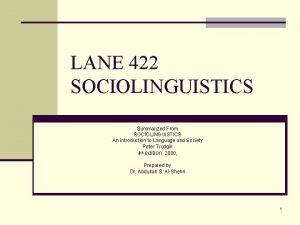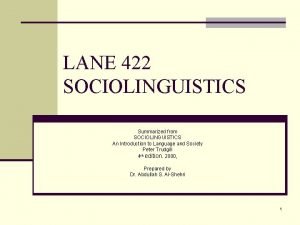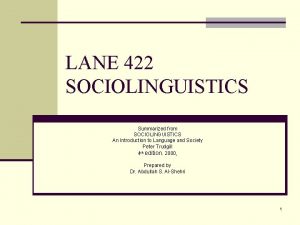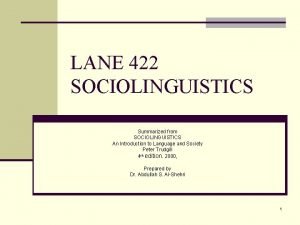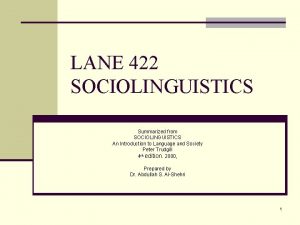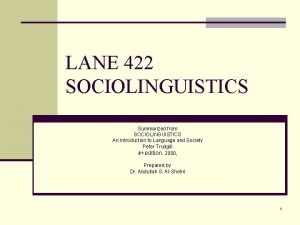LANE 422 SOCIOLINGUISTICS Summarized from SOCIOLINGUISTICS An Introduction










- Slides: 10

LANE 422 SOCIOLINGUISTICS Summarized from SOCIOLINGUISTICS An Introduction to Language and Society Peter Trudgill th 4 edition. 2000, Prepared by Dr. Abdullah S. Al-Shehri 1

Chapter 6 Language and Social Interaction 2

In the last chapter. . n We examined the relationship between language and social context. n We saw that in style-shifting, dialect-switching, diglossia, and language switching, there is a relationship between the social situation and the choice of language variety. 3

In this chapter. . We shall see that: n These kinds of shifting and switching are not solely determined by the social situation where speakers just respond automatically to social situations or contexts. n Speakers can also use switching for their own purposes: that is to manipulate or influence or define the situation as they wish, and to convey nuances of meaning and personal intention. 4

We shall also see that. . n The study of the way in which language is used in conversations is an important part of sociolinguistics. n Sociolinguists have looked at the way in which language can be used for manipulating relationships and achieving particular goals. n sociolinguists have also looked at rules for the conducting and interpretation of conversation generally, and at the way these may differ from society to society. 5

For example. . n Code-switching is presumably a subconscious linguistic behavior, and it has the effect of making the conversation more intimate and/or confidential. n It also enables speakers to signal two identities at once. n In other cases, the selection of one code over another seems to depend on the topic of discussion. 6

In different societies. . n Children learn the rules of conversation, along with the pronunciation, vocabulary and grammar. n They learn that in the structure of conversation there are points where it is possible, and points where it is not possible, to interrupt a speaker. n They learn the rules about how and when one is allowed to introduce a new topic of conversation. n They even learn rules about silence. n When such rules are broken, people usually acknowledge that fact and apologize. 7

All societies then. . n Have rules about the way in which language should be used in social interaction. n These rules may vary widely between one society and another. n An example of this is the way people make or answer telephone calls in different societies. n Differences in communicative rules between cultures can often lead, in cross-cultural communication, to misunderstanding and even hostility. n The study of these rules, and of cross-cultural differences in communicative norms generally, is often known as the ethnography of speaking. 8

Interestingly. . n The American sociolinguist Deborah Tannen has suggested that communication between men and women can be regarded as cross-cultural communication, which maybe subject for misunderstanding. n She suggested that men and women often fail to understand one another properly, and that such misunderstandings can lead to friction and tension in relationships. n Some people who have read her book on this subject have written to her to say that sociolinguistics has saved their marriages. 9

Directness / Indirectness n One aspect of communication that may cause problems of miscommunication is the relationship between directness and indirectness. n Direct questions, for example, can be particularly threatening, and in many English-speaking societies some direct questions are hardly ever asked, such as: How much money do you earn? Are you married? How old are you? Etc. n Questions of this kind will typically be accompanied by some overt recognition that this is a problematic linguistic activity, for example: How old are you – if I may ask? How much did you pay for it – if you don’t mind telling me? Do you mind if I ask if you’re married? n Indirectness then may be an important strategy if one is to spare themselves and others the embarrassment. 10











